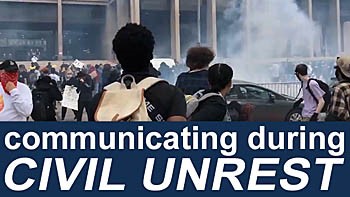


Inform, Don’t Alarm – Communicating Before & During Civil Unrest
By Howard Fencl, Hennes Communications
Considering the Supreme Court’s epic Roe v. Wade decision, its decision to loosen New York City’s gun laws, unrelenting gun violence across the country and the prospect that the upcoming mid-term elections may result in the seizure of ballots in certain battleground states, emotions are likely to boil over and out of control. The possibility of civil unrest looms.
If you’re in a leadership position, in local government, at a nonprofit or in the private sector, you must be ready to communicate with your employees and other stakeholders at a moment’s notice should the worst happen in your location, potentially impacting your operations. If your organization has no crisis communications plan, here is a quick checklist of communication outreach tactics and content you should take time to prepare before they’re needed. As has been said by many, “We’ll wing it” isn’t a plan.
Crisis Communications Content
- Latest news updates
- Operational updates
- Messages from top leadership
- Safety/security tips for staff and visitors
- Traffic alerts including road closures, alternate routes, parking
- Curfew letter identifying employees and acknowledging their need for after-hours access
- Shuttle escort info
- Employee Assistance Program information and availability
- Area hotel rate discounts
- Work from home plans and instructions
Crisis Communications Tactics
- Cancel scheduled on-premises events – communicate this ASAP to staff, invitees, and other impacted constituents
- Regular text messages updating staff on operational status
- Clearly defined chain of command for communications approval
- Use of employee communications tools to keep staff informed with regular updates
- Intranet or dedicated staff page on public website
- Staff email
- Face-to-face communications
- Bulletin boards
- Outreach to external audiences
- Organizational website
- Organizational social media platforms
- Database driven emails (customers, suppliers, volunteers, etc.)
- Be prepared to immediately cut-off normal advertising, banner ads, pre-scheduled sales emails, etc. in order to ensure those ads don’t sound insensitive or tone-deaf
- If your website or blogs are handled by an employee or an outside marketing firm, be certain you have the log-in credentials to be able to pull those plugs yourself, especially if multifactor authentication/access has been set up
Engage your communications agency partners as soon as a situation develops. They can help you get communications out quickly, freeing you to make the decisions needed to keep operating. Plan for the unexpected as the situation unfolds and adjust your communications accordingly.
Start ratcheting back the frequency of your communications as the crisis lessens and resolves. And while nerves may fray if the issue is prolonged, remember to do everything in your power to keep your communications objective, calm and informative. Your internal and external audiences are looking to you for guidance in the midst of a trying, emotionally wrenching situation. Be their voice of reason.
Once the issue has resolved, re-convene your leadership team and your communications agency partners to review your outreach and conduct an after-crisis SWOT Analysis (Strengths, Weaknesses, Opportunities, Threats). What worked? What didn’t? And what can you do better the next time crisis communications are needed?